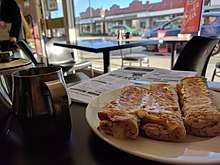Cheese roll
A cheese roll (occasionally known by the older name of cheese roll-up) is a snack food similar to Welsh rarebit, but created by covering a slice of bread in a prepared filling consisting mainly of grated or sliced cheese, and then rolling it into a tube shape before toasting. Cheese rolls are a very popular food in Otago and Southland of New Zealand, where they are commonly found as a menu item at cafeterias and similar food outlets, and uncommonly referred to as southern sushi.[1] They are one of only a very small number of recipes which are specific to only one of New Zealand's two main islands.
 Cheese rolls at a Café in Milton, Otago, New Zealand | |
| Alternative names | Cheese roll-up |
|---|---|
| Place of origin | New Zealand |
| Main ingredients | Bread, cheese |
Recipes
The dish is very simple to prepare, involving at minimum a slice of bread and cheese. More often, added ingredients are placed into a filling mixture, which is prepared earlier. These ingredients typically include onion, Worcestershire sauce, and onion soup mix though other fillings, such as crushed pineapple or sweet corn are also known.[2] An important factor in the preparation of cheese rolls is that this filling mixture is prepared separately before being added to the bread, rather than the filling simply being a slice of cheese covered with any other ingredients.
The bread is kept in a rolled shape either by breaking the crust so that the slice does not spring back into a flattened shape or by skewering the bread with toothpicks. The outer side of the roll is occasionally coated thinly in butter before toasting to add to the flavour and give the toasted roll a more golden appearance. The resulting roll has the advantages over simple cheese on toast of allowing for a more contrasting combination of a crisp outer surface with a soft interior (often with the cheese in a semi-liquid state), and its shape makes for easier eating.
Food researchers, notably Professor Helen Leach of the University of Otago, have identified three basic traditional styles of filling, with all known recipes seemingly a variant of these three.[3] The first of these recipes developed as a spread in the 1920s, prior to the invention of cheese rolls, using a specific spicy Australia cheese, Rex Cheese. Variants on this style of filling include the use of spicy or strong cheese with mustard, Worcestershire sauce, and even liqueurs such as Kahlúa. A second basic recipe again used spicy cheese, but this time mixed with savoury ingredients such as onion, which was cooked in butter or milk, mixed with the cheese, then thickened with flour or cornflour. A third version is similar to the second, but uses pre-processed food items as major ingredients, most notably dried onion soup mix and evaporated milk.
History
Early recipes for the dish date from the 1930s, with the earliest being in New Zealand newspaper New Zealand Truth from 1935.[4] Though known from this period, the popularity of the delicacy seems to have taken off with the widespread availability of sliced bread from the 1950s.[3] Early recipes referred to the dish under the seemingly disparaging name of "rat traps", a play on the longstanding nickname of "mouse traps" used for cheese on toast, but also likely a reference to the cylindrical shape, which was similar to commercial rodent traps of the era. The earliest known cookbook recipe for cheese rolls dates from Dunedin's Roslyn Church Jubilee Cookery Book in 1951, with numerous other South Island community cookbooks listing the recipe in the decade that followed. Cheese rolls were not found in any North Island cookbooks, however, until the late 1970s, and the food is still little known north of Waitaki River. The roll gained popularity in the south due to the cold climate and prevalence of soup as a meal option, especially during the frigid winter months. Artisan variations have now become a regional feature in various restaurants that incorporate alternate cheese and bread varieties.[5]
Fundraisers
Occasionally "Cheese roll fundraisers" are held, especially by schools and sports groups, in much the same way that "sausage sizzles" or barbecues can be.[6] Recent rises in the cost of dairy products have however made these fundraisers less profitable than they once were.[7]
See also
References
- insidersdunedin.co.nz Archived January 4, 2012, at the Wayback Machine
- SuperGran recipe site Archived May 24, 2008, at the Wayback Machine
- Smith, Charmian (22 November 2008). "A case of hard cheese". Otago Daily Times. p. 47. Retrieved 23 September 2011.
- "The Southland Cheese Roll". Southland, New Zealand. Retrieved 2020-07-10.
- "New Zealand's mighty cheese roll". TNZ Media. Retrieved 2020-07-10.
- Examples of this activity can be found in newsletters for Stirling School and Green Island school, both in Otago, as well as those for charitable organisations like Oxfam NZ
- "Prices cheese off fundraisers". The New Zealand Herald. April 2, 2008. Retrieved September 23, 2011.